7.x Black Mage Guide
By: Rika Vanih
Job Overview
Black Mage is a caster specializing in high, steady personal damage in place of providing party buffs. The job maintains a cyclical flow of expending MP via long, powerful casts in Astral Fire then swapping to refresh MP in Umbral Ice. While the rotation itself is somewhat simple, utilizing its movement tools and the flexibility built into its rotation to their fullest is key to maintaining uptime and maximizing damage as a Black Mage.
Basic Concepts/Resources
Astral Fire grants a damage bonus to all fire-aspected spells while doubling their MP cost. Ice-aspected spells have no MP cost in Astral Fire and deal less damage. At three stacks of Astral Fire, ice-aspected spell cast times are reduced by half. Astral Fire prevents MP regen, though things which grant MP directly like Manafont and Ethers still work.

Umbral Ice decreases the damage of fire-aspected spells, and casting ice-aspected spells replenish MP depending on current number of stacks. While in Umbral Ice, ice-aspected spells have no MP cost, and at three stacks of Umbral Ice fire-aspected spell cast times are reduced by half.
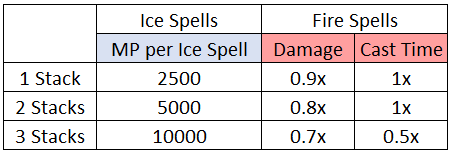
Unaspected Spells like Foul, Xenoglossy, Paradox, and Scathe do not count as fire-aspected or ice-aspected and so do not gain any damage bonus/penalty from either Astral Fire or Umbral Ice.
Enochian provides a personal passive bonus to all damage dealt, and is active while in either Astral Fire or Umbral Ice. It also remains active while swapping between Astral Fire and Umbral ice (even via Transpose), and is only lost upon completely dropping Astral Fire or Umbral Ice.
Umbral Hearts are a resource gained from casting Blizzard IV, Freeze (level 58+), or Umbral Soul. One Umbral Heart is consumed with each fire-aspected spell casted in Astral Fire (other than Flare and Despair), negating the increased MP cost. Flare instead will consume all current Umbral Hearts, and reduce the MP cost of the Flare by 1/3. This interaction is not present with Despair, which will use all remaining MP and not consume Umbral Hearts.
Polyglot is a resource gained every 30 seconds that Enochian is active. At level 80+, a maximum of two polyglot stacks can be held at a time. At level 98+, a maximum of three polyglot stacks can be held at a time. If the polyglot timer completes while at maximum stacks, no additional polyglot stack is gained, and the timer restarts at zero again. If Enochian is dropped the polyglot stacks remain, but the timer is reset to 0.
Paradox is a resource and spell available at level 90. When you have the resource, Paradox replaces both Fire and Blizzard on your hotbars. It is a strong spell that is instant-cast, providing a window for movement/weaving abilities. In Astral Fire, it also generates a guaranteed Firestarter proc. You gain a Paradox marker on your job gauge by transitioning from Umbral Ice III with three Umbral Hearts to Astral Fire, as well as from Astral Fire III to Umbral Ice.
Astral Soul is a resource available at level 100. Successful casting of Fire IV generates one Astral Soul stack, casting Flare grants three Astral Soul stacks. Generating the maximum of 6 stacks of Astral Soul allows for the user to cast Flare Star. Stacks are consumed upon casting Flare Star, and expire upon leaving Astral Fire.
Job Gauge
- Astral Fire/Umbral Ice stacks
- Umbral Hearts
- Polyglot stacks
- Polyglot timer
- Paradox marker
- Astral Soul Stacks
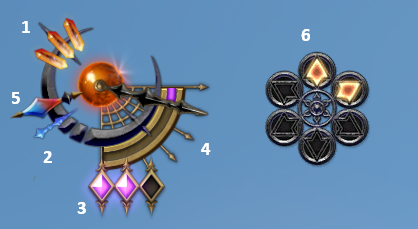
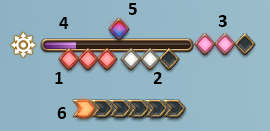
General Gameplay
In Astral Fire, the goal is to use all of your MP on six Fire IV casts and end in Flare Star and Despair. Somewhere within the phase, Paradox should be used for both damage as well as generating a Firestarter proc.
In Umbral Ice, Blizzard IV is used to obtain three Umbral Hearts (as well as produce a Paradox marker when entering Astral Fire again), as well as refresh MP for the next Astral Fire cycle. The Paradox generated upon entering Umbral Ice from Astral Fire III is also used in this phase.
In either stance, keeping the High Thunder DoT up is important, as well as utilizing polyglot stacks for Xenoglossy for movement/weaving/damage as needed.
Opener
Standard 5+7 Opener
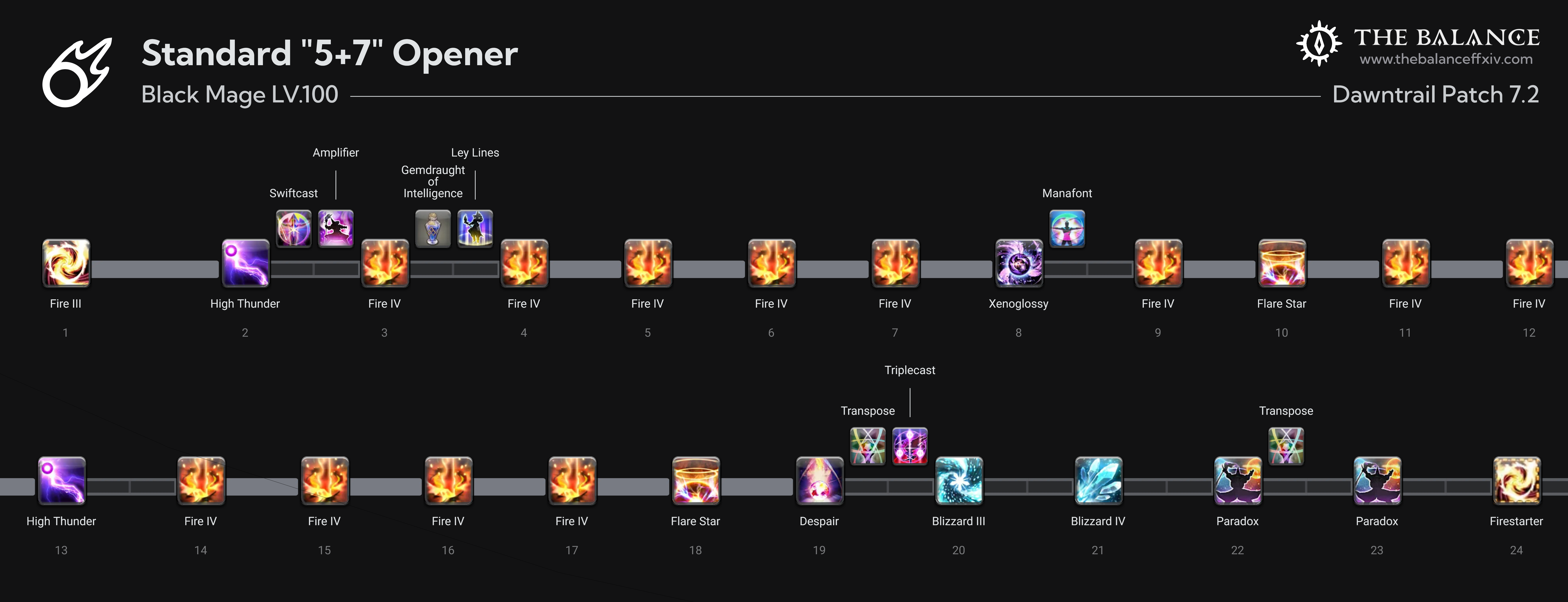
The standard opener for BLM. This opener skips a Despair cast pre-Manafont as well as a Paradox cast post-Manafont in order to cast 12 total Fire IV casts (5 before and 7 after Manafont, thus the name “5+7”), enabling two uses of Flare Star.
The initial Fire III cast should start around 4 seconds prepull (to land at the same time the boss is pulled). High Thunder should be refreshed just before raid buffs are falling off, which may shift depending on spell speed and party buff timing.
Additional notes:
- The second charge of Ley Lines can be flexibly used at any point after the opener, with the goal of using it during a window where its full duration can be used.
- Triplecast and Swiftcast usage is fairly flexible as needed in the opener for movement, but should still ideally be weaved after an instant-cast spell. At very low spell speeds, Swiftcast will come off cooldown to be available for the Umbral Ice I Blizzard III usage as pictured.
- This opener does not generate a Firestarter proc due to skipping the Paradox in Astral Fire. As a result, in order to consistently generate the proc for stronger reentry into Astral Fire III you should continue to use Paradox as your first spell in Astral Fire until at least the next Manafont cycle.
Alternative Single-Target Flare Opener
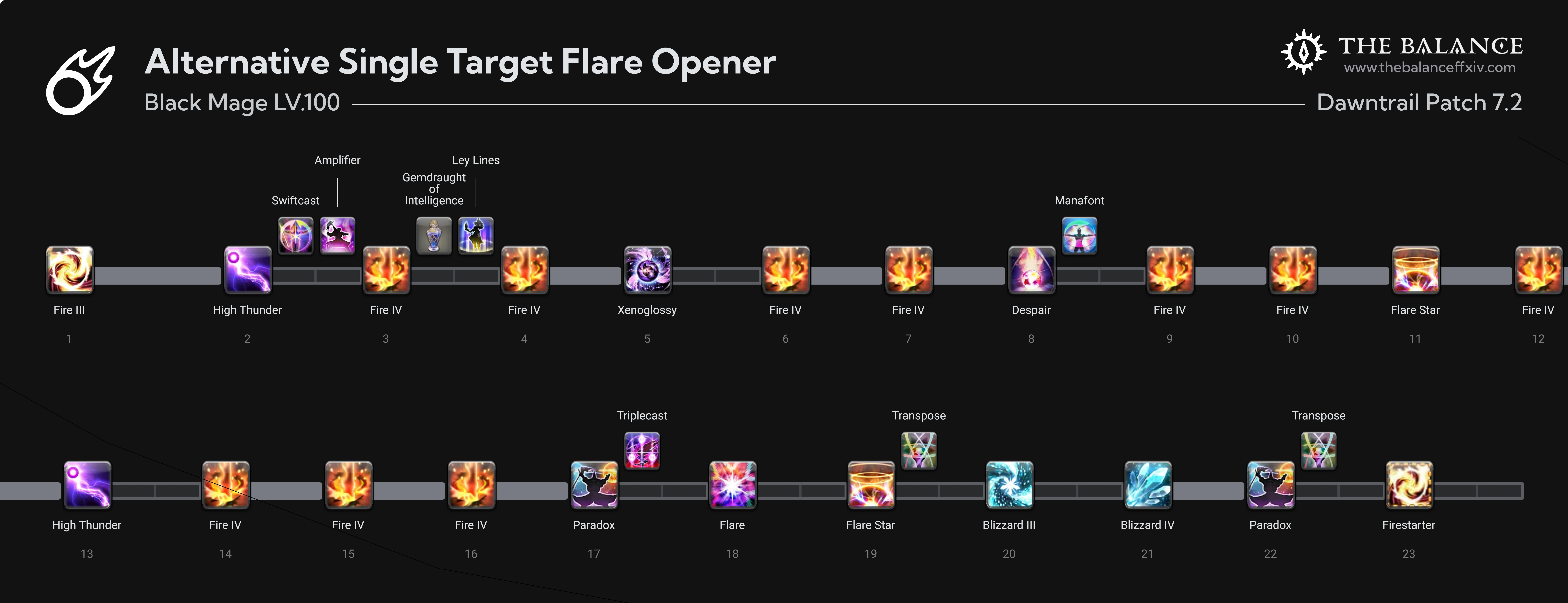
This alternative opener leverages Flare to generate sufficient Astral Soul stacks for a second Flare Star in the opener. The initial Fire III cast should start around 4 seconds prepull (to land at the same time the boss is pulled). High Thunder should be refreshed just before raid buffs are falling off, which may shift depending on spell speed and party buff timing.
While a minor loss compared to the Standard opener, this opener allows for casting Paradox post-Manafont. This generates a Firestarter proc for use in the following Astral Fire cycle, allowing for more flexible Paradox usage in subsequent cycles compared to the Standard opener.
If you were to use the Standard opener and would want or otherwise need to regain this flexibility by casting Fire III from Umbral Ice III instead of the recommended Astral Fire I -> Paradox -> Firestarter, you will lose less from swapping to this Alternative Opener to begin with.
Additional notes:
- The second charge of Ley Lines can be flexibly used at any point after the opener, with the goal of using it during a window where its full duration can be used.
- Triplecast and Swiftcast usage is fairly flexible as needed in the opener for movement, but should still ideally be weaved after an instant-cast spell.
- The placement of Xenoglossy is flexible in the opener but should ideally be used within the raid buff window.
- This opener can sometimes be referred to as “Potato Rotato” as homage to an old Stormblood BLM optimization nicknamed “Potato Rotato”, similarly leveraging Triplecast for single-target Flare and Umbral Ice I Blizzard III.
Single Target Rotation
Rotation Overview

The standard format for the single target rotation loop is as above, entering after the end of an Astral Fire phase. We have some measure of flexibility with reordering these spells, especially due to the removal of Astral Fire/Umbral Ice timers in Patch 7.2, but overall in some order plan to do the following each loop:
- Enter Astral Fire III via Firestarter proc used in Astral Fire I
- Cast six Fire IV casts to generate sufficient Astral Soul stacks to cast Flare Star
- Use Paradox in both Umbral Ice and Astral Fire (generating a Firestarter proc in Astral Fire)
- Cast Flare Star
- Cast Despair after all of your Fire IV and Paradox casts
- Enter Umbral Ice III via Blizzard III (ideally in Umbral Ice I to negate the 30% penalty from casting in Astral Fire III instead, made instant via Swiftcast or Triplecast)
- Cast Blizzard IV in Umbral Ice III to get back to full MP
In the situation where you do not have a Firestarter proc from the previous Astral Fire phase when entering a new one, such as after the Standard opener, the Paradox should specifically be used at the start of Astral Fire:

When doing this, you are running on a sort of “Firestarter deficit”, needing to continue to generate a new proc at the start of each Astral Fire phase until the following Manafont cycle where you can regain flexibility with Paradox usage once more.
Separate to the main rotational loop but still important, High Thunder should be maintained and Xenoglossy should be utilized, as detailed in the following sections.
High Thunder
Replacing the previous Thunder/Thundercloud system in previous expansions is the new Thunderhead system. Thunderhead is granted from gaining Astral Fire or Umbral Ice from either neutral or swapping between the two. The Thunderhead buff lasts for 30 seconds, allowing the user to cast either their single target or AoE Thunder spell and consuming the buff in the process. At level 100, these spells are High Thunder and High Thunder II, respectively.
In general, the goal for single target is to use High Thunder when the DoT is about to fall off (less than 3s remaining on the DoT timer). Since one cycle through Astral Fire and Umbral Ice is longer than 30 seconds, the refresh timing will not have a set place in your rotation, and instead will naturally drift.
A few important notes:
- A large portion of the damage from High Thunder comes from the DoT damage, with less on the initial hit compared to procs from last expansion. As a result, letting the DoT fall off for a while and losing DoT ticks or conversely having enough early refreshes to result in an extra refresh is fairly costly and should be generally avoided or otherwise accounted for when making situational decisions.
- While a fresh Thunderhead buff is obtained from every transition between Astral Fire and Umbral Ice, other than potentially for two-target situations it is not expected to use every proc, and instead just focus on refreshing when the DoT is falling off.
Xenoglossy
Xenoglossy is a powerful instant-cast spell that can be leveraged for movement or weaving as needed, in Astral Fire and/or Umbral Ice. With the ability to hold a third polyglot stack, it is now even easier to be more flexible with uses, with the potential to save stacks to use with raid buffs. This can be generally good practice, but movement considerations take priority.
AoE Rotation (3+ targets)
Rotation Overview
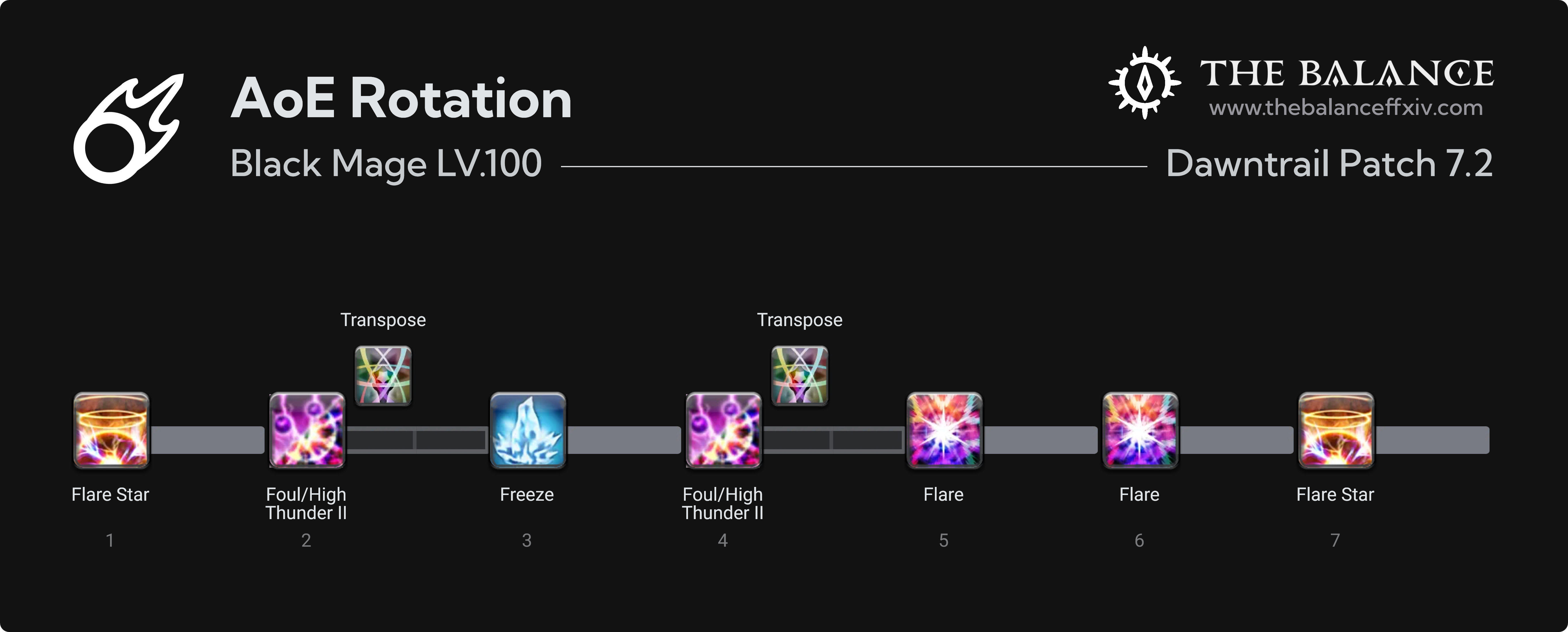
As adjustments to other elements of the job continue to lower the value of High Fire II and especially High Blizzard II, it is especially recommended to aim to skip these with Transpose whenever possible.
The Freeze cast in Umbral Ice I grants sufficient MP to use both Flare casts in the following Astral Fire. The filler spells (Foul/High Thunder II) are used to weave Transpose. Prioritize using High Thunder II for filler only when the DoT timer is lower to get the most value out of the DoT.
Manafont can be used for an additional two Flare casts followed by another Flare Star. Using any ether that grants at least 800 MP can be used for an additional Flare in dungeons and can still be worthwhile even though it will not enable an additional Flare Star by itself.
In a situation where you are running low on filler spells or otherwise anticipate a much longer time spent doing AoE, consider the following options to maintain skipping High Fire II/High Blizzard II:
- Use Triplecast to make the Flare casts and Flare Star instant, avoiding needing an additional filler to Transpose afterwards
- Consider using Paradox in Umbral Ice for a filler spell, particularly at lower mob counts/if there is a mob with higher HP in the encounter
- Clipping Transpose after Flare Star is only a small clip and allows for conserving filler spells for Umbral Ice, which is needed to wait out the Transpose cooldown
2-Target Situations
For 2-target situations where you are able to hit both targets at the same time, use the AoE rotation, substituting Freeze with Blizzard IV. Foul is now a gain in 2-target situations over Xenoglossy.
oGCD Abilities
Whenever possible, oGCD abilities should be weaved to avoid delays in casting. One oGCD ability can be used after Fire III/High Fire II from Umbral Ice III, and after Blizzard III/High Blizzard II from Astral Fire III. Up to two oGCD abilities can be weaved after instant-cast spells (Xenoglossy/Foul, Paradox, High Thunder/High Thunder II, Firestarter procs, or spells made instant via Swiftcast/Triplecast).
Most spells are now base 2 second cast time with 2.5 second recast time. This is not sufficient to allow for weaving without clipping, but if necessary will only lose a small amount of time.
In case of emergency to prevent deaths (using Addle, Manaward, or panic Aetherial Manipulation) or to keep uptime where it otherwise would not be possible, it situationally can still be good to use oGCD abilities even without weaving them. However, it is recommended to later figure out a better way to deal with the situation without relying on clipping oGCD abilities.
Below are general recommendations for usage of various oGCD abilities for BLM.
Ley Lines/Between the Lines/Retrace
Standing within Ley Lines grants the user the buff Circle of Power, reducing both the cast time and recast time of all spells. Since Ley Lines affects all GCDs and lasts for 20s, it does not need to be specifically lined up for use in Astral Fire, but instead should generally be used roughly off cooldown at the next available weaving window, with the second charge used when there is a window of time to make use of its full duration. Notably, since the recast time is also reduced for spells used within Ley Lines, even instant-cast spells gain value.
Fight-specific mechanics/timings may warrant specific positioning or potentially small delays in order to maximize overall uptime within Ley Lines. With the addition of the second charge to the ability with Patch 7.1, minor delays are unlikely to cause drift/missed uses over the course of a fight. In addition, there are some options for flexibility for mechanics without having to delay usage:
- It can be beneficial to stand at one edge of your Ley Lines by default. Many AoEs or other targeted mechanics are not large enough to cover them entirely, so by standing on one edge you may be able to dodge to the opposite edge.
- If you need to leave your Ley Lines for a short time, consider using an instant cast spell within them, moving out to dodge/handle a mechanic, and then use Between the Lines to return to them. If you are able to return before your next cast starts, you do not lose any effective uptime.
If you need to move out of your Ley Lines for a longer duration, such as a persistent ground AoE lingering where you had initially placed them, you can consider using Retrace to reposition them at your new location after moving away, once per Ley Lines duration.
Triplecast/Swiftcast
With Patch 7.2, most BLM spell cast times have been reduced below their recast time. This means that Triplecast and Swiftcast no longer save us time when used with most spells, and should be primarily used for movement/weaving. Note that these abilities are not used up on instant cast spells like Xenoglossy, Paradox, and High Thunder.
Movement/Weaving
The instant casts from Triplecast and Swiftcast are valuable for weaving other oGCD abilities, as well as continuing casting while moving for mechanics. Being able to keep casting in situations where it would be impossible otherwise provides much more benefit than any other option, and should be the primary consideration.
Instant Blizzard III
An additional consideration for Swiftcast or Triplecast is usage along with Transpose to increase the damage of Blizzard III. When casted in Astral Fire III, Blizzard III takes a 30% damage penalty, so using Transpose to enter Umbral Ice before using it removes this penalty. The Triplecast/Swiftcast makes the Blizzard III instant so it is not subject to the otherwise slow cast time in Umbral Ice—without this, it is not worthwhile over just casting the spell in Astral Fire.
Manafont
In Dawntrail, Manafont grants full MP and Umbral Hearts, and provides both a Thunderhead buff and a Paradox marker. Therefore, outside of the opener it should primarily be weaved at the tail end of an Astral Fire phase when it is available, in order to get full value of a second Astral Fire phase along with a second Flare Star.
Due to the specific placement in the rotation, Manafont will rarely line up to be used strictly on cooldown, often incurring some (often significant) delay in usage. Since it is not a burst cooldown and does not have notable value in lining it up with raid buffs, this drift by itself is often not a large issue. However, if the collective drift over the course of a fight results in missing out on an entire usage, it may be worthwhile to look into options for shifting alignment to be able to get maximum uses out of Manafont.
Miscellaneous
Amplifier: used roughly on cooldown, as long as it will not overcap the Polyglot gauge and waste a stack.
Aetherial Manipulation: movement tool used when a party member is in a position to move to, in order to reposition for a mechanic or whatever else may be required. Mostly useful when the distance required to travel is larger than a slidecast or current available movement tools will allow for. Consider using a macro for focus target as listed in the Appendix.
Manaward: solid personal shield which can be used proactively to help with mitigation, or reactively if needed to survive a mechanic.
Transpose: used primarily when bosses become untargetable/die while in Astral Fire, in order to swap to Umbral Ice to allow use of Umbral Soul. Can also be used for some optimizations for both single target and for AoE.
Addle: used to lower damage dealt by the target, more effective on magic-based damage. Consider planning uses in a static environment, otherwise use when available to help mitigate raidwide damage.
Surecast: used to nullify knockback/draw-in effects in order to help keep uptime.
Lucid Dreaming: Astral Fire prevents MP refresh effects like Lucid Dreaming, and using an ice-aspected spell in Umbral Ice III grants full MP. As a result, this ability will generally not be used.
Downtime and Recovery
Inevitably when learning a fight (and the job itself), there will be situations where maintaining the rotation perfectly will not be possible, or otherwise interrupted by downtime. In these cases, learning what to best do across downtime is extremely beneficial.
Handling Downtime and End of Fight
Depending on the length and type of downtime, there are a few options to consider for prep before/after downtime.
Before downtime/end of fight:
- Other than some rare situations, DoTs do not tick while enemies are untargetable (and of course will not deal damage after the target is dead). Unless the DoT ticks nearly fully, it is often less worthwhile to apply/refresh High Thunder before downtimes/end of fight/during short uptime phases.
- Ensure that you will not overcap on polyglot stacks during downtime, and that you use up all of your stacks before the end of a fight. Xenoglossy is the strongest BLM spell, so it is important to not miss any uses.
- Try to prioritize strong spells before downtime. For example, if you are unable to get both Despair and Flare Star off right before downtime, the Flare Star takes priority. For longer downtime, if using Flare over a Fire IV will enable using Flare Star where you would not otherwise, it will likely be worthwhile to do so.
- An instant cast frontloads its damage at the start of the GCD, so it is good practice to plan to end on an instant cast before the downtime/end of fight. This can result in a last tap of damage where a normal cast would not have been able to finish otherwise.
Continuing across/after downtime:
- With the removal of Astral Fire and Umbral Ice timers, for short downtime you will often just be able to resume your rotation where you left off, even in Astral Fire. Aim to end on an instant-cast before the downtime, but otherwise you will often be able to continue without extra effort.
- For moderate length downtimes, you will often be able to use Umbral Soul to get back to full MP with three Umbral Hearts. Even if you are in the middle of an Astral Fire cycle, getting back to full MP and three Umbral Hearts without having to cast Blizzard III and Blizzard IV is very high value. Consider trying to rush a Flare Star and otherwise dump your MP before downtime (potentially by using Flare) to make the most use of it.
- For slightly longer downtime situations, in some cases you may have used Umbral Ice Paradox and/or not have a Thunderhead proc to use next uptime. With the extra time, after getting to Umbral Ice III with three Umbral Hearts via Umbral Soul, consider using Transpose to head back into Astral Fire to generate Paradox, then Transpose back into Umbral Ice, using Umbral Soul to build back up to Umbral Ice III with three Umbral Hearts before you have uptime again.
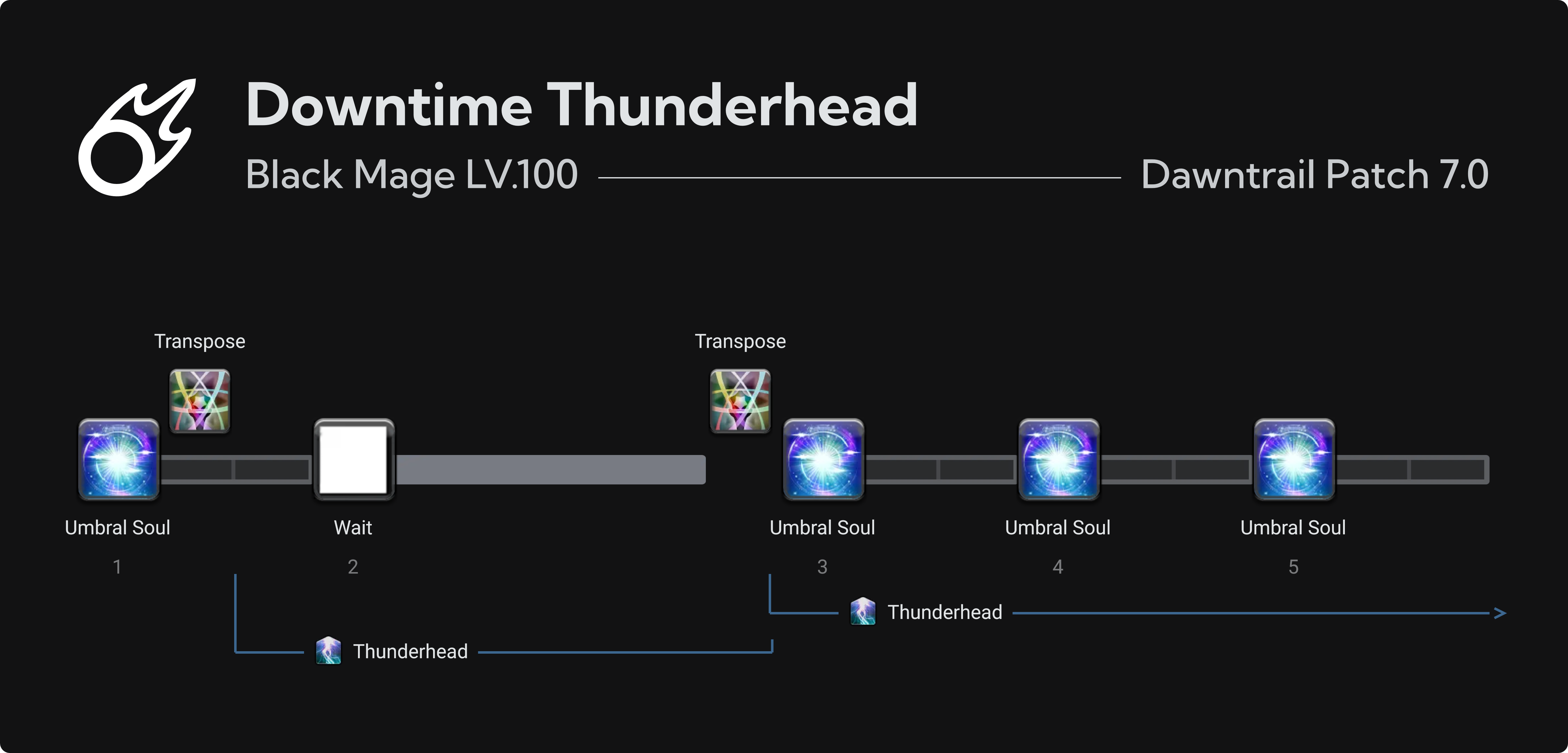
- Of note, especially for downtime before AoE in dungeons, you can easily Transpose to Astral Fire after all the mobs are grouped together to apply High Thunder II before continuing on with your Flares/Flare Star.
Recovering After a Death
With the changes for Patch 7.2, one of the few ways that you may end up completely dropping Astral Fire/Umbral Ice is by dying. After waiting until a safe time to accept the raise/start casting, reenter your rotation with Blizzard III (made instant via Swiftcast/Triplecast if available), applying High Thunder if it has fallen off, cast Blizzard IV then continue on into the standard cycle.
Appendix
Macros
Manually targeting to use Aetherial Manipulation can often result in minor delay due to needing to change targets multiple times. Therefore, a common alternative is to use a mouseover macro for the ability:
/merror off
/ac "Aetherial Manipulation" <mo>
/ac "Aetherial Manipulation" <mo>
/ac "Aetherial Manipulation" <mo>
/ac "Aetherial Manipulation" <mo>
/ac "Aetherial Manipulation" <mo>
/ac "Aetherial Manipulation" <mo>
/ac "Aetherial Manipulation" <mo>
/ac "Aetherial Manipulation" <mo>
/ac "Aetherial Manipulation" <mo>
/ac "Aetherial Manipulation" <mo>
/ac "Aetherial Manipulation" <mo>
/ac "Aetherial Manipulation" <mo>
/micon "Aetherial Manipulation"
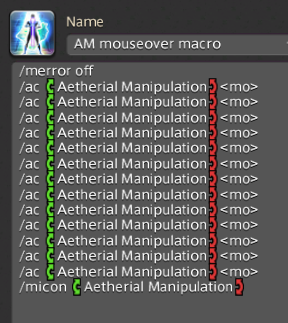
Hovering over the character model of a party member, or even their name in the party list, and then pressing the macro will use Aetherial Manipulation on them without changing target. If the flexibility for regular targeting is desired, the bottom
Common Abbreviations
For this document, full names of spells, buffs, and abilities were used for clarity. However, these are frequently abbreviated in regular discussion. Below are the most common abbreviations for these:
- F1, F2, F3, F4: Fire spells, the number designates the rank (i.e. F1 = Fire, F2 = Fire II, etc.)
- B1, B2, B3, B4: Blizzard spells, the number designates the rank (i.e. B1 = Blizzard, B2 = Blizzard II, etc.)
- T1, T2, T3, T4: Thunder spells, the number designates the rank (i.e. T1 = Thunder, T2 = Thunder II, etc.)
- HT, HT2: High Thunder and High Thunder II, respectively
- FS: Flare Star
- HF2/HB2: High Fire II, High Blizzard II
- AF1, AF2, AF3: Astral Fire, Astral Fire II, and Astral Fire III respectively
- UI1, UI2, UI3: Umbral Ice, Umbral Ice II, Umbral Ice III respectively
- Eno: Enochian
- Xeno: Xenoglossy
- Para: Paradox
- Amp: Amplifier
- LL: Ley Lines
- Triple: Triplecast
- Swift: Swiftcast
- AM: Aetherial Manipulation
- BtL: Between the Lines
- Poly: Polyglot
- MF: Manafont
- Lucid: Lucid Dreaming
- SpS/sps: Spell Speed
- Pot: Main stat (Intelligence) potion, current strongest option is HQ Grade 2 Gemdraught of Intelligence
- GIRL: Geiji Ice Recovery Line, a recovery option to get back into the regular rotation
Acknowledgements
Big thanks to my fellow mentors Fürst Blumier and Reina Leigh for their work and support, as well as all of the BLM Helpfuls.
And also to all the various BLM players on the Balance–whether you’re one of the bigger names who help teach others or otherwise just hang out, one of the newer players asking questions to help learn and improve, or anyone in between, know that you’re very much appreciated <3



